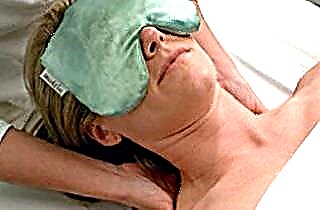The maxillary cavities are located in the thickness of the upper jaw. They communicate with the nasal cavity through a natural excretory opening. When, due to an attack of viruses, the mucous membrane in the nose becomes inflamed, swelling appears. As a result, the outlet is narrowed and closed. Of course, such pathological changes also affect the mucous membrane lining the maxillary sinuses (sinuses). It also becomes inflamed, as a result of which there is a violation of the natural outflow from them. Such conditions are very favorable for the reproduction of harmful microorganisms. If both sinuses are inflamed, bilateral maxillary sinusitis (bilateral sinusitis) develops.
Note that double-sided sinusitis is almost always severe enough. There is a high risk of the disease becoming chronic and the appearance of dangerous complications.
Why arises
 Often, bilateral sinusitis is caused not by one, but by several external factors at once. The inflammatory process in both maxillary sinuses at once can occur when:
Often, bilateral sinusitis is caused not by one, but by several external factors at once. The inflammatory process in both maxillary sinuses at once can occur when:
- decreased immunity;
- chronic diseases of the nasopharynx and oral cavity;
- incorrect treatment of rhinitis.
The cause of the appearance of bacterial bilateral sinusitis can also be severe hypothermia. In this case, it either develops on its own, or comes “complete” with a runny nose, pharyngitis, sore throat and other colds. If the acute form of sinusitis is treated at the wrong time or incorrectly, the disease will become chronic and will annoy with constant relapses.
Congenital anomalies of the anatomical structure of the paranasal sinuses contribute to the development of this ailment. Those with such an anomaly have an increased risk of developing bilateral sinusitis by up to 40%.
As already mentioned, this disease is a natural result of occlusion of the mouth in the maxillary canal. Through this channel, the mucus formed in the paranasal cavities should freely leave the sinuses. The overlap of the mouth leads to a violation of the natural outflow of serous mucus and pus from the maxillary cavity. The infection spreads to adjacent cavities most often during sleep. This happens when a person lies on the healthy side.
The disease can also provoke an ordinary allergic reaction. Pollen of flowering plants, household dust, pet hair, as well as some products in the presence of food allergies, become a kind of triggering factor in this case.
Other reasons for the development of bilateral maxillary sinusitis include:
- periodically exacerbated vasomotor rhinitis, occurring in a chronic form;
- recently transferred scarlet fever, measles or diphtheria (mainly in children);
- injuries to the nose or paranasal sinuses, in particular, received during the operation;
- pulpitis and periodontitis.
The last 2 causes cause inflammation first in one cavity. Then it spreads to two maxillary sinuses.
Varieties of bilateral sinusitis
 Depending on the nature of the inflammation of the maxillary sinuses, there are 3 types of bilateral sinusitis:
Depending on the nature of the inflammation of the maxillary sinuses, there are 3 types of bilateral sinusitis:
- catarrhal;
- exudative;
- purulent.
Experts consider the catarrhal type of disease to be the easiest. It appears as a result of a virus infection. The mucous membrane that lines the sinuses swells slightly. Colorless, viscous mucus, devoid of any odor, is secreted from the nasal passages.
In the acute form of exudative sinusitis, a significant amount of mucus of a watery consistency is released. Due to the fact that the full outflow of mucous secretion from the sinuses is disrupted, it accumulates there, creating favorable conditions for the development of dangerous infections - both bacterial and fungal.
The acute form of purulent sinusitis appears as a result of direct infection with harmful bacteria. It can also occur due to the addition of a bacterial infection with maxillary sinusitis of the catarrhal or exudative varieties. This type of disease can be recognized by a viscous discharge that has a yellowish and greenish color, with a very unpleasant odor and an admixture of pus. Such discharge usually flows down the pharynx (in particular, along the back wall). They are partly coughing up and partly swallowed.
Symptoms of the disease
Symptoms of bilateral sinusitis are very similar to those of unilateral sinusitis. The only difference is that they appear on a larger scale - on both sides of the face.
So, the development of bilateral maxillary sinusitis can be suspected when:
 feeling of tension and pressure in the area of the paranasal cavities;
feeling of tension and pressure in the area of the paranasal cavities;- redness and swelling of the skin of the face;
- toothache without a specific localization;
- headache concentrating in the region of the nose and forehead;
- a stuffy nose;
- trouble breathing through the nose;
- mucous and purulent discharge from the nose, as well as a foul-smelling thick mass flowing down the pharynx (in particular, along its back wall), after which a very unpleasant aftertaste remains;
- a feeling of fullness in the eye sockets (it gets a little better when lying down);
- partial loss of the ability to smell.
If you ignore bilateral maxillary sinusitis in the initial stage of its development (catarrhal type of inflammation), it can become purulent.
The symptoms of purulent sinusitis are more pronounced. Added to them is an increased temperature, which persists for a long time. Acute bilateral inflammation of the maxillary sinuses often subsequently becomes chronic. The congestion of pus inside the cavities allows bacteria to enter the bone and periosteum. In this case, it is not possible to completely remove the infection from the sinuses.
The chronic form of the course of bilateral maxillary sinusitis is not as pronounced as acute. The fact that the disease has become chronic is indicated by:
- frequent nasal congestion
- almost constantly felt headache,
- general weakness
- decreased ability to work,
- problems with smell.
In addition to the listed symptoms, it should be noted the regularity of the occurrence of exacerbations, as a result of which the bone is affected even more deeply. The risk of developing dangerous complications also increases significantly.
Treatment methods
 Antibacterial therapy.
Antibacterial therapy.
It is advisable if there is one hundred percent certainty that sinusitis was provoked by bacteria. After all, if the disease has arisen due to a virus, even the best antibiotic will be absolutely powerless.
To make the treatment as effective as possible, the doctor suggests making a test for the resistance of the detected bacteria to antibiotics of different groups. However, such an analysis takes a long time, and many do not want to waste time waiting. Therefore, some patients choose medication at their own discretion.
Most often, with bilateral sinusitis, "Amixicillin", "Ampicillin", "Macropen", "Zitrolide", "Cephalexin" and others are prescribed.
- Antihistamines.
If exacerbations occur constantly at the same time of the year, the doctor may suspect an allergic type of disease. For confirmation, the patient is assigned a blood test (necessarily detailed), by which the allergen can be quickly identified.
By the way, the doctor can prescribe antihistamines without a blood test. But only if he constantly observes the course of the patient's disease and knows its features.Treatment is usually prescribed with Tavegil, Suprastin, Tsetrin, Claritin, Klarotadin and Zirte.
- "Cuckoo".
If the disease is not started, the otolaryngologist recommends a so-called sinus evacuation using a soft catheter. A solution of "Furacilin" is injected into the nostril through the catheter. At the same time, by means of a special suction, a mixture of medicine and purulent contents is pumped out of the maxillary cavity. In the process of carrying out this unpleasant procedure, the patient must pronounce "cuckoo" so that "Furacilin" does not go down the throat (hence the name).
 The effectiveness of the "Cuckoo" is not very high - it may be necessary to several of these washings of the paranasal sinuses.
The effectiveness of the "Cuckoo" is not very high - it may be necessary to several of these washings of the paranasal sinuses.
- Puncture of the maxillary sinuses.
If all of the above methods are unsuccessful, doctors resort to surgical intervention. Local anesthesia is given first. After that, a needle is used to puncture the bone septum separating the maxillary sinus and the nasal passage. Without removing the needle, a syringe is connected to it. Then the inner contents of the cavity are washed out with saline solution. After completing the flush, the doctor injects a dioxidine solution into the sinus to prevent further pus filling.
Consequences and complications
Often, bilateral sinusitis is complicated if the therapy was untimely and incorrect. For example, a person suffers from a persistent runny nose for a long time, and is in no hurry to see a doctor. At the same time, rhinitis is treated exclusively symptomatically, using the advertised drops for vasoconstriction. Meanwhile, the inflammatory process is actively developing, pus accumulates in the paranasal cavities. If we add to this a decrease in immunity, complications cannot be avoided.
Severe consequences of this disease can appear as a result of improper rinsing of the nose or the use of traditional medicine that cause allergic swelling or are completely useless for sinusitis.
 The consequences of bilateral sinusitis pose a certain danger to health, and sometimes even to life. This ailment can lead to the development of rhinosinusitis, otitis media, tracheitis, tonsillitis, bronchitis, endocarditis, as well as a number of purulent diseases - an abscess of the orbit, phlegmon of the soft tissues of the orbit, meningitis. Treatment of the latter complication is carried out exclusively in a hospital setting. Moreover, the result of therapy is far from always successful. The same applies to the phlegmon of the orbit - there is a risk of going blind.
The consequences of bilateral sinusitis pose a certain danger to health, and sometimes even to life. This ailment can lead to the development of rhinosinusitis, otitis media, tracheitis, tonsillitis, bronchitis, endocarditis, as well as a number of purulent diseases - an abscess of the orbit, phlegmon of the soft tissues of the orbit, meningitis. Treatment of the latter complication is carried out exclusively in a hospital setting. Moreover, the result of therapy is far from always successful. The same applies to the phlegmon of the orbit - there is a risk of going blind.
Sepsis, brain abscess and thrombosis of its vessels caused by sinusitis are extremely dangerous. They can make a person disabled or even fatal.
Post factum
In order to prevent the development of bilateral sinusitis, you need not to overcool your head and engage in the prevention of colds. Also, it is impossible to prevent the transition of diseases of the ear and nasopharynx into a chronic form.
By the way, chronic sinusitis can become only in one case out of ten. As a rule, in the case of chronicity of the disease, exacerbations alternate with remissions. It is necessary to treat this ailment until the problem is completely eliminated. This is the only way to avoid complications.
The treatment regimen should, of course, be chosen by the otolaryngologist. However, it is desirable that a neurologist, dentist and allergist also express their opinion.

 feeling of tension and pressure in the area of the paranasal cavities;
feeling of tension and pressure in the area of the paranasal cavities; Antibacterial therapy.
Antibacterial therapy.

